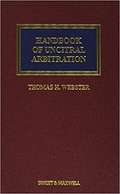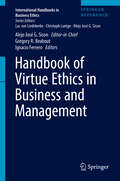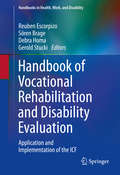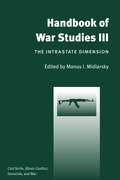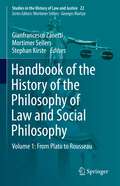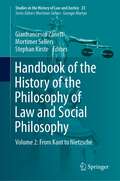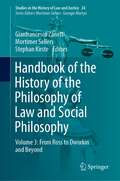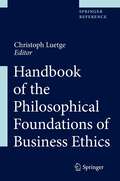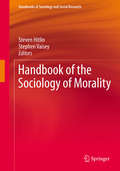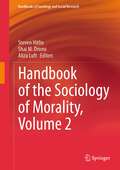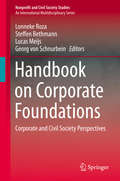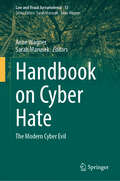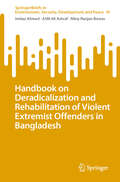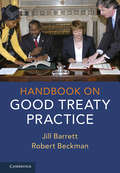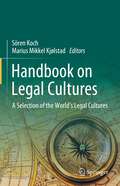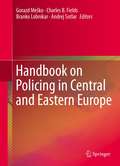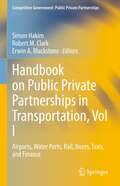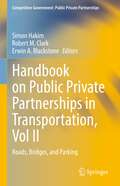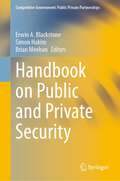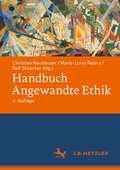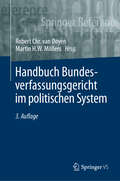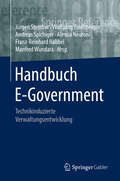- Table View
- List View
Handbook of Trace Evidence Analysis
by Vincent J DesiderioCovers new trace evidence techniques and expanding areas of analysis, along with key theory and applications Developed around the need for updated information in the disciplines of trace evidence the Handbook of Trace Evidence Analysis focuses on the increasing awareness and need for validation, modern methods for addressing and controlling contamination, the shift towards incorporating statistical analyses into the interpretation phase and cutting edge research into new forensic science methods and their application. Beginning with an overview of the topic and discussing the important role that information derived from trace materials can provide during investigations, the book then presents chapters on key techniques. The first being the critical nature of microscopy, and the methods employed for the recognition, collection, and preservation of trace evidence. Subsequent chapters review the core disciplines of trace evidence examination: paints and polymers, hairs, fibers and textiles and glass. Each chapter contains in-depth discussions on the origin of the materials involved, including any natural or synthetic processes involved in their production, the nuances involved in their detection, and the methods of analysis that are used to extract valuable information from samples. In addition, suggested workflows in method and testing selections, as well as addressing specific scientific challenges as well as the limitations of knowledge on the transfer, persistence and background abundance of trace materials are discussed. The book ends by examining the interpretation of trace evidence findings from a historical perspective and examining the methods that are currently being developed. Provides an in-depth introduction to the general area of trace evidence and discusses current and new techniques Consolidates trace evidence and materials categories of testing into one reference series Offers a detailed focus on technical approaches and guidelines to trace evidence Includes analytical schemes/workflows and valuable guides for the interpretation of data and results The Handbook of Trace Evidence will appeal to forensic science academics, students, and practitioners in the trace evidence and materials science disciplines, as well as DNA analysts, toxicologists, forensic anthropologists, crime laboratory managers, criminal justice students and practitioners, and legal professionals. It would also be a valuable resource for every crime laboratory reference library.
Handbook of UNCITRAL Arbitration
by Thomas H. WebsterThis title deals with arbitration under the UNICITRAL Arbitration Rules 2009. The book supplies a systematic review of the UNICITRAL arbitration process from start to finish, via rule-by-rule analysis of the new rules.
Handbook of Virtue Ethics in Business and Management (International Handbooks in Business Ethics #1)
by Alejo José G. Sison Gregory R. Beabout Ignacio FerreroThis volume examines the breadth and depth of virtue ethics and aims to counter the virtue ethics amnesia that both afflicts general moral philosophy and affects business and management ethics. Divided into two parts, the handbook starts out with a historical introduction and chronology of the development of virtue ethics, providing a comprehensive assessment of its evolution and identifying the most influential authors and their works. The authors discussed include those who follow a philosophical or conceptual tradition in their treatment of virtue and those who belong to the research tradition of positive science, in particular, empirical, quantitative and applied psychology. The second part of the book discusses systematic approaches and major themes developed in virtue ethics. These contributions are conceptual, empirical/applied or case studies. They offer insight into the different topics to which virtue ethics has been applied, and show how virtue ethics has influenced the various operational areas of firms. Finally, they examine the virtue ethics responses to some of the most important issues that businesses and organizations face in the 21st century.
Handbook of Vocational Rehabilitation and Disability Evaluation
by Reuben Escorpizo Sören Brage Debra Homa Gerold StuckiThis book presents the state of the art in the application and implementation of the WHO's International Classification of Functioning, Disability and Health (ICF) in the areas of vocational rehabilitation as a primary topic and disability evaluation as a secondary topic. Application of the ICF and implementation strategies toward a holistic and comprehensive approach to work disability and vocational rehabilitation programs are presented along with clinical cases and exercises. The ICF as a topic in health and disability has been gaining momentum since its approval by the World Health Assembly in 2001, and great progress has been made since then. However, the integration if the ICF in the realm of vocational rehabilitation has been lacking despite the fact that work and employment are a major area in people's lives, particularly those who have work disability. This book will advance the professional practice of vocational rehabilitation, rehabilitation counseling, occupational medicine, and allied health science.
Handbook of War Studies III: The Intrastate Dimension
by Manus I. MidlarskyHandbook of War Studies III is a follow-up to Handbook of War Studies I (1993) and II (2000). This new volume collects original work from leading international relations scholars on domestic strife, ethnic conflict, genocide, and other timely topics. Special attention is given to civil war, which has become one of the dominant forms - if not the dominant form - of conflict in the world today.
Handbook of the History of the Philosophy of Law and Social Philosophy: Volume 1: From Plato to Rousseau (Studies in the History of Law and Justice #22)
by Mortimer Sellers Stephan Kirste Gianfrancesco ZanettiThis Handbook discusses representative philosophers in the history of the philosophy of law and social philosophy, giving clear concise expert definitions and explanations of key personalities and their ideas. It provides an essential reference for experts and newcomers alike.
Handbook of the History of the Philosophy of Law and Social Philosophy: Volume 2: From Kant to Nietzsche (Studies in the History of Law and Justice #23)
by Mortimer Sellers Stephan Kirste Gianfrancesco ZanettiThis Handbook discusses representative philosophers in the history of the philosophy of law and social philosophy, giving clear concise expert definitions and explanations of key personalities and their ideas. It provides an essential reference for experts and newcomers alike.
Handbook of the History of the Philosophy of Law and Social Philosophy: Volume 3: From Ross to Dworkin and Beyond (Studies in the History of Law and Justice #24)
by Mortimer Sellers Stephan Kirste Gianfrancesco ZanettiThis Handbook discusses representative philosophers in the history of the philosophy of law and social philosophy, giving clear concise expert definitions and explanations of key personalities and their ideas. It provides an essential reference for experts and newcomers alike.
Handbook of the Philosophical Foundations of Business Ethics
by Christoph LuetgeThe Handbook of Business Ethics: Philosophical Foundations is a standard interdisciplinary reference handbook in the field of business ethics. Articles by notable philosophers and economists examine fundamental concepts, theories and questions of business ethics: Are morality and self-interest compatible? What is meant by a just price? What did the Scholastic philosophers think about business? The handbook will cover the entire philosophical basis of business ethics. Articles range from historical positions such as Aristotelianism, Kantianism and Marxism to systematic issues like justice, religious issues, rights and globalisation or gender. The book is intended as a reference work for academics, students (esp. graduate), and professionals.
Handbook of the Sociology of Morality
by Stephen Vaisey Steven HitlinHuman beings necessarily understand their social worlds in moral terms, orienting their lives, relationships, and activities around socially-produced notions of right and wrong. Morality is sociologically understood as more than simply helping or harming others; it encompasses any way that individuals form understandings of what behaviors are better than others, what goals are most laudable, and what "proper" people believe, feel, and do. Morality involves the explicit and implicit sets of rules and shared understandings that keep human social groups intact. Morality includes both the "shoulds" and "should nots" of human activity, its proactive and inhibitive elements. At one time, sociologists were centrally concerned with morality, issues like social cohesion, values, the goals and norms that structure society, and the ways individuals get socialized to reproduce those concerns. In the last half-century, however, explicit interest in these topics has waned, and modern sociology has become uninterested in these matters and morality has become marginalized within the discipline. But a resurgence in the topic is happening in related disciplines - psychology, neurology, philosophy, and anthropology - and in the wider national discourse. Sociology has much to offer, but is not fully engaged in this conversation. Many scholars work on areas that would fall under the umbrella of a sociology of morality but do not self-identify in such a manner, nor orient their efforts toward conceptualizing what we know, and should know, along these dimensions. The Handbook of the Sociology of Morality fills a niche within sociology making explicit the shared concerns of scholars across the disciplines as they relate to an often-overlooked dimension of human social life. It is unique in social science as it would be the first systematic compilation of the wider social structural, cultural, cross-national, organizational, and interactional dimension of human moral (understood broadly) thought, feeling, and behavior.
Handbook of the Sociology of Morality, Volume 2 (Handbooks of Sociology and Social Research)
by Steven Hitlin Shai M. Dromi Aliza LuftThis handbook articulates how sociology can re-engage its roots as the scientific study of human moral systems, actions, and interpretation. This second volume builds on the successful original volume published in 2010, which contributed to the initiation of a new section of the American Sociological Association (ASA), thus growing the field. This volume takes sociology back to its roots over a century ago, when morality was a central topic of work and governance. It engages scholars from across subfields in sociology, representing each section of the ASA, who each contribute a chapter on how their subfield connects to research on morality. This reference work appeals to broader readership than was envisaged for the first volume, as the relationship between sociology as a discipline and its origins in questions of morality is further renewed. The volume editors focus on three areas: the current state of the sociology of morality across a range of sociological subfields; taking a new look at some of the issues discussed in the first handbook, which are now relevant in sometimes completely new contexts; and reflecting on where the sociology of morality should go next. This is a must-read reference for students and scholars interested in topics of morality, ethics, altruism, religion, and spirituality from across the social science.
Handbook on Corporate Foundation: Corporate and Civil Society Perspectives (Nonprofit and Civil Society Studies)
by Steffen Bethmann Lonneke Roza Lucas Meijs Georg Von SchnurbeinCompanies increasingly play a meaningful role in civil society and the philanthropic sector through Corporate Social Responsibility (CSR) and Corporate Philanthropy (CP). The most well studied form of allocating these resources is through outright contributions to operating external foundations and other nonprofit organizations. However, far less is known about the use of corporate foundations, separate and independent nonprofit entities aimed at channeling corporate giving to a social mission related to a company. Corporate foundations are often linked to the founding company through their name, funding, trustees, administration and potential employee involvement. As these foundations are growing in number, size and importance and becoming increasingly visible in the philanthropic sector, the urgency to understand their role and functioning becomes more important.The primary aim of this volume is to deliver a holistic analysis of the current state-of-the-art on corporate foundations. For that reason, the book includes different perspectives on and use a hybrid concept of corporate foundations. The book includes three main parts. First, looking further into the organizational processes of corporate foundations, the book analyzes governance and operations as major aspects of organizational performance. Second, it sheds light on the role of corporate foundations in various institutional settings. Lastly, the book includes various stakeholder perspectives on corporate foundations, including corporate employees, beneficiaries, and their non-profit partners. By reading the book, readers will build a comprehensive understanding of the role and functioning of corporate foundations, understand new avenues for research and, in case they are practitioners in the field, find practical advice rooted in academic research.
Handbook on Cyber Hate: The Modern Cyber Evil (Law and Visual Jurisprudence #13)
by Anne Wagner Sarah MarusekCyberhate is defined as racist, discriminatory, negationist and violent statements made on social network platforms, text platforms, comment pages, and more. The Handbook on Cyber Hate, the Modern Cyber Evil, includes twenty-seven chapters from scholars representing over fifteen countries from the Global North and the Global South demonstrating a range of multi-faceted perspectives. While providing such a focus, these papers will also operate with a constantly evolving conceptualization of contemporary societies and their modern cyber-evil. Indeed, modern cyber-evil is a global concern and is primarily based on human minds and activities, and on deviant uses of modern technologies, which may differ ideologically, historically and culturally on the global map of modern legal systems. This plurality of perspectives, which poses a challenge to our future, is a strength of this handbook that offers a variety of foundations, legal perspectives, and popular developments in an effort to suggest measures to combat this modern cyber-evil infecting communications around the world. Editors Anne Wagner and Sarah Marusek offer a unique collection of chapters involving the theoretical foundations, legal perspectives, and societal perspectives from popular culture of modern cyber evil in order to address and combat racism on the basis of alleged race, skin color, nationality, descent and national or ethnic origin, etc.; discrimination/xenophobia on the basis of sex, gender, sexual orientation, religious or philosophical beliefs, health status, physical characteristics, etc.; hatred; violence; e-predation; and e-victimization. Advance Praise for “Handbook on Cyber Hate – The Modern Cyber Evil” “In 'Handbook on Cyber Hate – The Modern Cyber Evil', editors Anne Wagner and Sarah Marusek have masterfully created a much-needed resource for understanding the complex and ever-changing landscape of online hate and cyberbullying. This comprehensive handbook delves deep into the murky waters of cyberevil, offering insightful semiotic and transdisciplinary perspectives from a wide range of international scholars. Each chapter deftly navigates the theoretical, legal, and societal dimensions of cyberhate, shedding light on the complex interplay between technology, law, and culture. The book's exploration of cyber hate is not just academic, but a call to action. It encourages readers, denizens of the digital semiosphere, to recognize and combat the insidious nature of online hate, equipping them with knowledge and strategies for creating a safer digital world. Covering topics from the study of benign exhibitionism, the boundaries between speech and action in cyberhate, legal intricacies of that speech, trolling in social media and hegemonic masculinity, to the cinematic portrayal of cyberbullying and the malicious use of memes: this handbook is a beacon of hope and guidelines in our increasingly digital society. What sets this handbook apart is its holistic approach. It not only identifies problems, but in many cases inspires solutions, fostering a culture of responsible digital citizenship and empathy. This is not just a book, but a road map for creating a more inclusive and compassionate online community. As we face the challenges of the digital age, 'Handbook on Cyber Hate – The Modern Cyber Evil' is an indispensable handbook for researchers, educators, policy makers and all who seek to understand and combat the complexities of cyber hate. This is a must-read for shaping a more respectful and empathetic digital world.” Kristian Bankov, Professor of Semiotics, New Bulgarian University “In the present time of great confusion caused by the blurring of the lines of distinction between the real and virtual worlds, between artificial and human forms of intelligence and even between good and bad technologies representative for expressions of love and hate, the ‘Handbook on Cyber Hate – The Modern Cyber Evil’ brings an
Handbook on Deradicalization and Rehabilitation of Violent Extremist Offenders in Bangladesh (SpringerBriefs in Environment, Security, Development and Peace #41)
by Imtiaz Ahmed Niloy Ranjan Biswas ASM Ali AshrafThis Handbook provides a theory-driven and policy-relevant analysis of terrorist offenders' deradicalization processes. It is the product of a multi-year collaboration between security studies scholars and counterterrorism practitioners. It offers a multidimensional strategy for the physical and cognitive disengagement of terrorists. It also charts a path for the community-based social reintegration of rehabilitated extremist offenders. The Handbook is targeted for both academics and practitioners in the field of counterterrorism. Those specializing in South Asia and the Global South will find this book a useful reference tool to comprehend and design the complex deradicalization processes and transform them into implementable practices.
Handbook on Good Treaty Practice
by Robert Beckman Jill BarrettThis Handbook aims to provide practical guidance on good treaty practice. It presents a range of examples from the practice of several States and international organisations and explains the actions that need to be taken to create a new treaty, bring it into force, operate it, amend it and wind it up, on both the international and the domestic plane. It also explores what constitutes good treaty practice, and develops generic principles or criteria against which to evaluate these examples. It provides a useful analytical tool to enable each government and international organisation to identify and develop the best treaty practice for their circumstances, recognising that one size does not necessarily fit all. It will be of interest to those working with treaties and treaty procedures in governments, international organisations and legal practice, as well as legal academics and students wishing to gain insight into the realities of treaty practice.
Handbook on Legal Cultures: A Selection of the World's Legal Cultures
by Sören Koch Marius Mikkel KjølstadCooperation across borders requires both knowledge of and understanding of different cultures. This is especially true when it comes to the law. This handbook is the first to comprehensively present selected legal cultures based on a very specific set of structural elements which can be found in all such cultures. Legal cultures are a product of and impacted by certain fundamental and commonly shared ideas on and expectations of the law. In all modern societies these ideas are to a certain degree institutionalized or at least embedded in institutionalized practices. These practices determine the way lawyers are educated and apply the law, how they engage with the ongoing internationalization of law and what kind of values they adhere to. Looking at these elements separately enables the reader to identify similarities and differences and to explain them contextually. Understanding these general features of legal cultures can help avoid misunderstandings or misinterpretations of foreign law and its application. Accordingly, this handbook is a necessary starting point for all kinds of legal comparative studies conducted by academics, students, judges and other legal practitioners.
Handbook on Policing in Central and Eastern Europe
by Andrej Sotlar Charles B. Fields Gorazd Meško Branko LobnikarPolicing in Central and Eastern Europe has changed greatly since the fall of the Berlin Wall. Some Central and Eastern European countries are constituent members of the European Union, while others have been trying to harmonize with the EU and international requirements for a more democratic policing and developments in accordance with Western European and international policing standards, especially in regard to issues of legality and legitimacy. Changes in the police training system (basic and advanced), internationalization of policing due to transnationalization of crime and deviance, new police organizational structures and agencies have impacted new cultures of policing (from exclusively state to plural policing). This timely volume examines developments in the last two decade to learn the nature of these changes within Central and Eastern Europe, and their impact on police culture, as well as on society as a whole. The development of police research has varied widely throughout Central and Eastern Europe: in some countries, it has developed significantly, while in others it is still in its infancy. This work will allow for a transfer of ideas and models of police organization and policing is also need to be studies closely, with an aim to provide consistent and comparable data across all of the countries discussed. For the twenty countries covered, this systematic work provides: short country-based information on police organization and social control, crime and disorder trends in the last 20 years with an on policing, police training and police educational systems, changes in policing in the last 20 years, police and the media, present trends in policing (public and private, multilateral, plural policing), policing urban and rural communities, recent research trends in research on policing - specificities of research on police and policing (researchers and the police, inclusion of police researchers in policy making and police practice) and future developments in policing.
Handbook on Public Private Partnerships in Transportation, Vol I: Airports, Water Ports, Rail, Buses, Taxis, and Finance (Competitive Government: Public Private Partnerships)
by Erwin A. Blackstone Simon Hakim Robert M. ClarkThis book discusses the role of public-private partnerships (PPPs) in global transportation infrastructure. Seen as a way to provide vital services in an era of shrinking government budgets, public-private partnerships have become an increasingly important part of travel infrastructure worldwide. This book describes and analyzes the structure of various models of PPPs in various countries, evaluating their effectiveness, and drawing policy implications for future use. Written by leading international researchers and practitioners in the transportation field, each chapter is a case study on the adoption, implementation, and outcome of transportation services in different municipalities. Taken together, these diverse case studies provide an integrated framework for evaluating and using PPPs. Providing rigorous empirical analysis of PPPs in transportation, this volume will be of interest to researchers in public administration, political science, and economics as well as practitioners and policymakers involved in establishing and monitoring PPPs in transportation.
Handbook on Public Private Partnerships in Transportation, Vol II: Roads, Bridges, and Parking (Competitive Government: Public Private Partnerships)
by Erwin A. Blackstone Simon Hakim Robert M. ClarkSecond in a two-volume set, this book discusses the role of public-private partnerships (PPPs) in global transportation infrastructure, specifically focusing on roads, bridges, and parking. To provide vital services in an era of shrinking government budgets, public-private partnerships have become an increasingly important part of travel infrastructure worldwide. This book describes and analyses the structure of various models of PPPs in several countries, evaluating their effectiveness, and drawing policy implications for future use. The chapters were written by leading international researchers and practitioners in the transportation field where each chapter is a case study on the adoption, implementation, and outcome of transportation services. Taken together, these diverse case studies provide an integrated framework for evaluating, using PPPs, and suggesting policy implications to both the public and the private sectors in transportation. Providing rigorous empirical analysis of PPPs in transportation, this volume will be of interest to researchers in public administration, political science, public choice, and economics as well as practitioners and policymakers involved in establishing and monitoring PPPs in transportation.
Handbook on Public and Private Security (Competitive Government: Public Private Partnerships)
by Erwin A. Blackstone Simon Hakim Brian MeehanThis Handbook discusses the use of public-private partnerships in law enforcement and security. Written by international experts across multiple disciplines, chapters include case studies and cross-sectional industry-wide studies of private security performance in comparison with public police and collaborated experiences of the two sectors. The Handbook uses existing experiences and public economics to suggest how to improve security and social welfare through greater competition and cooperation between public and private security. This volume provides an integrated framework to assist policymakers in both public and private agencies. This Handbook will be an important reference for scholars in public economics, public administration, criminology, and criminal justice, as well as professionals and policymakers in the public and private sectors.
Handbuch Angewandte Ethik
by Christian Neuhäuser Marie-Luise Raters Ralf StoeckerAufgabe der Angewandten Ethik ist es, in privaten und öffentlichen Problemlagen konkrete Hilfestellung für eine ausgewogene Beurteilung der Situation und das moralisch richtige Verhalten zu geben. Dieses Handbuch lokalisiert die Angewandte Ethik systematisch und interdisziplinär und gibt einen Überblick über die zentralen Bereichsethiken. Zudem erläutert es Begriffe, die für alle Anwendungsfelder relevant sind (z.B. Personalität, Verantwortung, moralische Dilemmata). Der Hauptteil widmet sich ethischen Einzelthemen aus verschiedenen Bereichen: dem Privatleben des Menschen (z.B. Liebe und Freundschaft, Behinderung, Sexualität und Geschlechtlichkeit), dem Sozialleben und der staatlichen Ordnung (z.B. Grund- und Menschenrechte, Strafe und Strafvollzug, Rassismus und Sexismus, Interkulturelles Zusammenleben, Armut und Hunger), der medizinischen Ethik (z.B. Ethik der Pflege, Forschung am Menschen, Gentherapie, Intensivmedizin, Kosmetische Chirurgie und Enhancement) sowie der Umwelt- und Tierethik. Für die 2. Auflage wurde das Handbuch durchgesehen, umfassend aktualisiert und um mehrere Beiträge (u.a. Finanzethik, Philosophische Praxis, Flucht und Migration, Altern, Ethik der Stammzellforschung) sowie ein neues Kapitel über „Ethische Fragen der Digitalisierung“ erweitert.
Handbuch Betriebliches Umweltmanagement
by Gabi Förtsch Heinz MeinholzIn kompakter Form stellt dieses Handbuch das notwendige Wissen für das betriebliche, nachhaltige Umweltmanagement zur Verfügung. Es ist als Nachschlagewerk zur Einführung und Fortschreibung eines Umweltmanagementsystems konzipiert. Darüber hinaus kann es als Lehrbuch bzgl. der Grundaspekte des betrieblichen Umweltmanagements verwendet werden.
Handbuch Bundesverfassungsgericht im politischen System
by Robert Chr. van Ooyen Martin H. W. MöllersDas politikwissenschaftliche Standardwerk unterzieht Stellung und Funktion des Bundesverfassungsgerichts im Spannungsfeld von Politik und Recht einer umfassenden sozial- und rechtswissenschaftlichen Analyse. Vollständig überarbeitet und aktualisiert bietet die dritte Auflage fundierte Einblicke in den politischen Prozess und die (rechts-)politischen Implikationen der Verfassungsrechtsprechung. Dabei werden theoretische Grundfragen der Verfassungsgerichtsbarkeit, methodische Zugänge der Analyse, vergleichende Bezüge,historische Entwicklungen und Konfliktlinien miteinbezogen. Die dritte Auflage beinhaltet 70 Beiträge und ist als Reference-Handbuch konzipiert.
Handbuch E-Government: Technikinduzierte Verwaltungsentwicklung (Springer Reference Wirtschaft Ser.)
by Wolfgang Eixelsberger Jürgen Stember Andreas Spichiger Alessia Neuroni Franz-Reinhard Habbel Manfred WundaraDieses Handbuch stellt die aktuellen Herausforderungen und neuen Lösungsansätze beim E-Government in den Ländern Österreich, Schweiz und Deutschland dar. Es werden alle drei administrativen Ebenen bearbeitet und aus der Perspektive der Praxis und der Wissenschaft betrachtet. Damit wird ein Forum für innovative und neue Ansätze geschaffen, um diese Konzepte in Praxis und Wissenschaft in Deutschland, der Schweiz und Österreich zur Diskussion zu stellen. Alle Beitragsautorinnen und -autoren haben umfangreiche Kompetenzen, Forschungsschwerpunkte und Praxisprojekte im E-Government und sind weitreichend in den jeweiligen nationalen Netzwerken vertreten. Das Handbuch richtet sich an Studierende, Wissenschaftlerinnen und Wissenschaftler unterschiedlicher Disziplinen genauso wie an Expertinnen und Experten aus der Praxis.
Handbuch Europarecht: Band 3: Beihilferecht
by Walter FrenzBand 3 behandelt das hochaktuelle Beihilfe- und Vergaberecht. Er stellt die Grundstruktur des Beihilfenverbotes und die einzelnen Beihilfeformen dar. Schwerpunkt dabei: Inwieweit kann die Erbringung von Leistungen der Daseinsvorsorge im Gefolge der Altmark Trans-Rechtsprechung staatlich unterstützt werden. Bei den Ausnahmen vom Beihilfenverbot sind Änderungen der europäischen Verordnungen und der Leitlinien der Kommission berücksichtigt. Mit neuen Richtlinien (RL 2004/18/EG (VKR); RL 2004/17/EG (SKR)) und der in der jüngsten EuGH-Rechtsprechung (Halle, Mödling, Carbotermo, Bari) problematisierten Abgrenzung ausschreibungsfreier In-House-Geschäfte.

